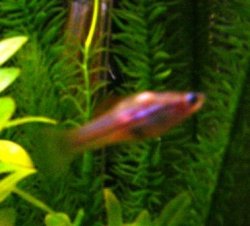spazzinout
Fish Fanatic
Ok so my swordtail has weird lumps on her. There white. She naturally is sort of translucent , so you can see the bumps inside of her. They have been there for about 2 weeks but recently the main one on her top has pushed up out of her body and is now like a tumor.
Ammonia- 0
Nitrite - 0
nitrate- 0
ph- 7.6 (this has been constant ever since i set up the tank, i think its just my local water)
check out the pics.
Ok i dont know if i uploaded the pics correctly, so heres a link if the pics dont show up.
http /tinypic.com/view.php?pic=5d0ac9&s=4
/tinypic.com/view.php?pic=5d0ac9&s=4
THANKS
Ammonia- 0
Nitrite - 0
nitrate- 0
ph- 7.6 (this has been constant ever since i set up the tank, i think its just my local water)
check out the pics.
Ok i dont know if i uploaded the pics correctly, so heres a link if the pics dont show up.
http
 /tinypic.com/view.php?pic=5d0ac9&s=4
/tinypic.com/view.php?pic=5d0ac9&s=4THANKS


